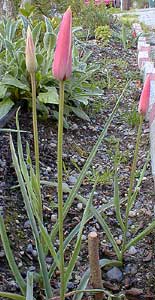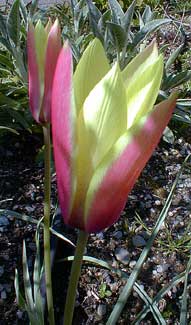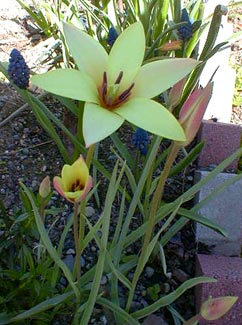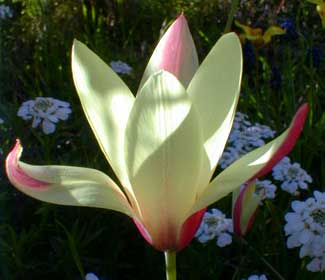
'Cynthia' Lady Tulip
aka Candlestick Tulip
"In the intimate dark there's never an ear
Though the tulips stand on tiptoe to hear."
-Hora Stellatrix
by Amy Lowell
by Amy Lowell
Formerly thought to have been native of the Middle East, Tulipa clusiana was sometimes known as the "Persian Tulip" for the belief that it originated in Persia. Even today, some texts continue to insist its native range is from Iran, Afghanistan, Uzbekistan, Tibet & Kashmir in northern India.
 If they'd added in Turkey they'd've hit all the bases with the odds of it having been partially correct seemingly a gambler's sure thing. However, the best experts now believe it to be indigenous to Spain! Uncertainty remains since it has managed to naturalize in so many regions, having been gardened through much of Europe since the early sixteen-hundreds.
If they'd added in Turkey they'd've hit all the bases with the odds of it having been partially correct seemingly a gambler's sure thing. However, the best experts now believe it to be indigenous to Spain! Uncertainty remains since it has managed to naturalize in so many regions, having been gardened through much of Europe since the early sixteen-hundreds.That it escaped to so many wild locations is somewhat mysterious since it does not seed & would be expected mainly to naturalize from offsets & by its wandering underground stolons, which ought to leave them fairly close to where initially planted planted.
 It must once have been so widespread in rural gardens that in some places there is no longer evidence of homesteading, except for the forever lingering hardy Lady Tulips.
It must once have been so widespread in rural gardens that in some places there is no longer evidence of homesteading, except for the forever lingering hardy Lady Tulips.Its mysteriousness of origin hints at the greater difficulty botanists have had retrospectively attempting to assess the origination of so many varieties of tulips. If the origin of a species tulip can be so uncertain, how much greater the difficulty in tracking down centuries of hybridizations. To date, the amazing diversity of the thousands of hybridized tulips cannot be tracked to any conceivable combination of wild species.
Today the sundry selected varieties of T. clusiana are collectively known as Candlesticks or Lady Tulips. The first April photo above shows 'Cynthia' just before the flowers open, when their "candlestick" appearance is at its most extreme. The second photo, a day or two later, shows the opening bloom.
The species is named after Clusius whose Curae posteriores (1606) mentions obtaining bulbs from a Florentine grower who had received them in 1606 from Constantinope. Clusius's bulbs were flourishing a year later. It was already at that time dubbed the Lady Tulip.
 The species is usually red & white resembling a peppermint stick, but the variety 'Cynthia' is striped red & yellow. 'Cynthia' was introduced to gardeners in 1959 by C. G. Van Tubergen. In our roadside sun-garden, the tall slender buds are coloring up & attractive after the first week of April. The pointed "flames" of the candles open into flat perfect stars by mid-April, lasting into May.
The species is usually red & white resembling a peppermint stick, but the variety 'Cynthia' is striped red & yellow. 'Cynthia' was introduced to gardeners in 1959 by C. G. Van Tubergen. In our roadside sun-garden, the tall slender buds are coloring up & attractive after the first week of April. The pointed "flames" of the candles open into flat perfect stars by mid-April, lasting into May.They grow eight inches to a foot tall. They require a warm & sunny location. Despite not seeding, this tulip easily increases by bulb offsets. It perennializes without effort, though it is somewhat at risk of winter rot if it experiences too much moisture during dormancy. With perfect drainage, in organically enriched sandy soil, they should come back yearly & spread on their own.
Occasionally T. clusiana expends so darned much energy creating roots, offsets, & stolons that it forgets to bloom quite well enough, & may need to be lifted to replant rather more often than other botanical tulips. So long as it has a warm, sunny location, however, it will eventually be productive & rewarding.
They sometimes seem to beg for propogation help, which means digging them up after they are done flowering & after the leaves have begun to die back, this in order to remove offsets & start them in pots until they are mature enough to go back into the garden. (The main bulb can be immediately placed back in its hole as soon as the offsets are harvested.)
To maximize the possibility of it naturalizing in place, however, do not trim foliage after it stops flowering; always wait for it to die back on its own. If the leaves are pruned back the bulbs will weaken & offsets will not mature. Position Lady Tulips where they will get maximum sun or full afternoon sun, & don't water them much. Though they love summer heat they are nevertheless temperate tulips for USDA zones 3 through 8; in zones with warmer winters they will not complete their life cycle because they require a chilly dormancy.
Growing immediately right of 'Cynthia' is a wild form of the same species, T. clusiana var chrystanthus.